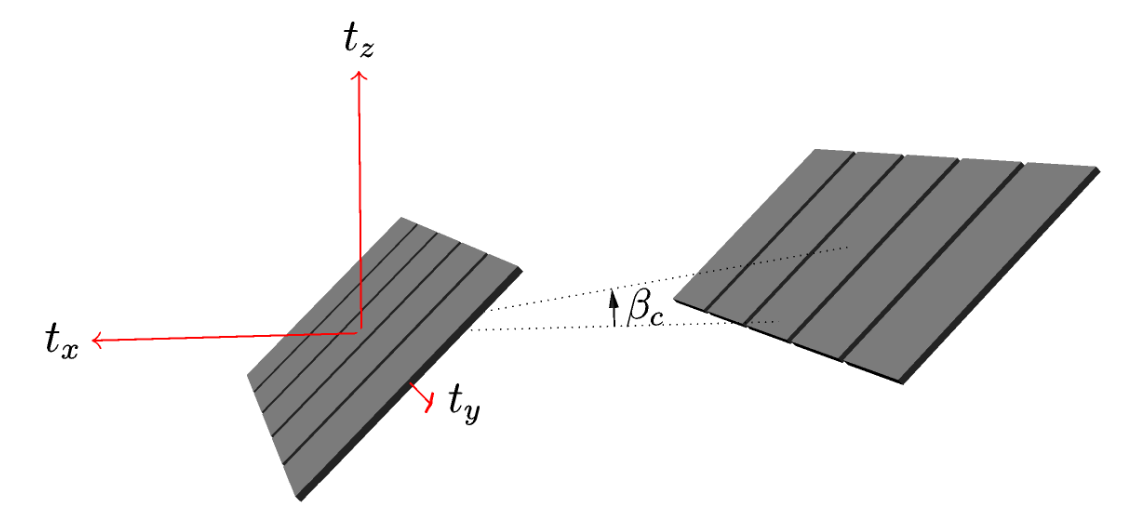Nomenclature#
There is a convention on consistent variable names throughout the library:
- airmass#
Airmass
- airmass_absolute#
Absolute airmass
- airmass_relative#
Relative airmass
- albedo#
Ratio of reflected solar irradiance to global horizontal irradiance [unitless]
- aoi#
Angle of incidence. Angle between the surface normal vector and the vector pointing towards the sun’s center. [°]
- aoi_projection#
cos(aoi). When the sun is behind the surface, the value is negative. For many uses, negative values must be set to zero.
- ape#
Average photon energy
- apparent_zenith#
Refraction-corrected solar zenith angle. The solar zenith angle describes the position of the sun relative to the vertical and is defined as the angle between a vector pointed straight up and a vector pointed at the sun, from the observer. [°]
- apparent_elevation#
Refraction-corrected solar elevation angle. This is the complement of apparent_zenith (90 - apparent_zenith). [°]
- axis_slope#
Angle of a tracker axis with respect to horizontal. This is, left-hand rotation angle of \(t_y\) around \(t_x\) in Fig. [4] of [Anderson2020]. See figure in cross_axis_slope.
- bhi#
Beam/direct horizontal irradiance
- cross_axis_slope#
Cross-axis slope angle. [°] The angle, relative to horizontal, of the line between the axes of two adjacent trackers, in the plane perpendicular to the tracker axes. Cross-axis slope should be specified using a right-handed convention.
For example, trackers with axis azimuth of 180° (N-S rotation axis) will have a negative cross-axis slope if the tracker axes plane slopes down to the east and positive cross-axis slope if the tracker axes plane slopes up to the east.

Fig. 4, [Anderson2020]: Cross-axis slope angle \(\beta_C\) relative to the tracker coordinate system.
Use :py:
pvlib.tracking.calc_cross_axis_slope()to calculatecross_axis_slope.See also axis_slope.
- dhi#
Diffuse horizontal irradiance
- dni#
Direct normal irradiance [Wm⁻²]. Irradiance received per unit area by a surface perpendicular (normal) to the sun’s rays that propagate in a straight line from the sun.
- dni_clear#
Clear sky direct normal irradiance
- dni_extra#
Direct normal irradiance at top of atmosphere (extraterrestrial)
- effective_irradiance#
Effective irradiance
- eta_inv#
Inverter efficiency
- eta_inv_nom#
Nominal inverter efficiency
- eta_inv_ref#
Reference inverter efficiency
- g_poa_effective#
Broadband plane of array effective irradiance
- gamma_pdc#
Module temperature coefficient. Typically in units of 1/C.
- ghi#
Global horizontal irradiance
- ghi_clear#
Clearsky global horizontal irradiance [Wm⁻²]
- ghi_extra#
Horizontal irradiance at top of atmosphere (extraterrestrial)
- gri#
Ground-reflected irradiance
- i_sc#
Short circuit module current
- i_x, i_xx#
Sandia Array Performance Model IV curve parameters
- latitude#
Latitude in decimal degrees. Positive north of equator, negative to south.
- longitude#
Longitude in decimal degrees. Positive east of prime meridian, negative to west.
- pac, ac#
AC power
- pdc, dc#
DC power
- pdc0#
Nameplate DC rating
- photocurrent#
Photocurrent
- poa_diffuse#
Total diffuse irradiance in plane [Wm⁻²]. Sum of ground and sky diffuse components of global irradiance.
- poa_direct#
Direct/beam irradiance in plane [Wm⁻²].
- poa_global#
Global irradiance in plane. Sum of diffuse and beam projection [Wm⁻²].
- poa_ground_diffuse#
In plane ground reflected irradiance [Wm⁻²].
- poa_sky_diffuse#
Diffuse irradiance in plane from scattered light in the atmosphere (without ground reflected irradiance) [Wm⁻²].
- precipitable_water#
Total precipitable water contained in a column of unit cross section from earth to top of atmosphere
- pressure#
Atmospheric pressure
- relative_humidity#
Relative humidity
- resistance_series#
Series resistance
- resistance_shunt#
Shunt resistance
- saturation_current#
Diode saturation current
- solar_azimuth#
Azimuth angle of the sun in degrees East of North. The solar azimuth angle describes the sun’s position along the horizon relative to the observer. The pvlib-python convention is defined as degrees East of North, so North = 0°, East = 90°, South = 180°, West = 270°.
- solar_zenith#
Zenith angle of the sun in degrees. This is the angle between is between a vector pointed straight up and a vector pointed at the sun, from the observer. This is the complement of solar elevation (90 - elevation). [°]
- spectra#
- spectra_components#
Spectral irradiance (components) [Wm⁻²nm⁻¹]. The amount of energy incident on a unit area per unit time and per unit wavelength. As with broadband irradiance, global spectral irradiance is composed of direct and diffuse components.
- surface_azimuth#
Azimuth angle of the surface in degrees East of North. This angle describes the horizontal projection of the normal vector from the surface. The pvlib-python convention is defined as degrees East (clockwise) of North, so North = 0°, East = 90°, South = 180°, West = 270°.
- surface_tilt#
Tilt from horizontal [°]. The surface tilt angle is defined as degrees from the horizontal such that a surface facing up would have a surface tilt of 0°, and one facing the horizon would be 90°. [°]
- temp_air#
Temperature of the air
- temp_cell#
Temperature of the cell
- temp_dew#
Dewpoint temperature
- temp_module#
Temperature of the module
- tz#
Timezone
- v_mp, i_mp, p_mp#
Module voltage, current, power at the maximum power point
- v_oc#
Open circuit module voltage
- wind_direction#
Wind direction
- wind_speed#
Wind speed
For further explanation of the variables, common symbols, and units, refer to the following sources from SoDa Service:
Note
These further references might not use the same terminology as pvlib. But the physical process referred to is the same.
References#
K. Anderson and M. Mikofski, ‘Slope-Aware Backtracking for Single-Axis Trackers’, National Renewable Energy Lab. (NREL), Golden, CO (United States); NREL/TP-5K00-76626, Jul. 2020. DOI: 10.2172/1660126.
